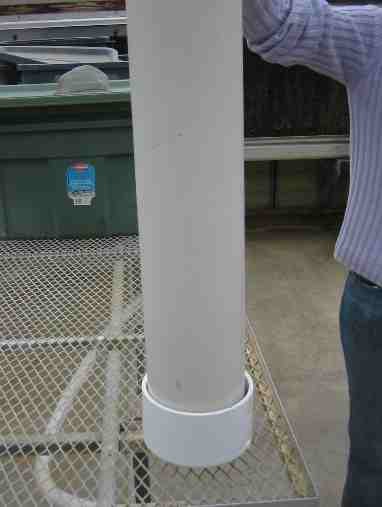
Finished mesocosm
We start with PVC pipes 3 m (10 feet) tall, 15.25 cm (6 inches) in diameter and 3 mm (1/8 inch) thick. They were cut in half with an industrial belt saw, so each half is 1.524 m (5 feet) long. The total volume per cylinder is 28 liters (7.4 gallon). The cylinders are supported in a 17.78 cm (7 inch) PVC cap with a perforation that allows drainage from the cylinders. Note that the cap does not need to be glued to the cylinder.

To support the cylinders we built a wooden base made with a plywood panel and 5 by 10 cm (2 by 4 inch) lumber. The plywood has holes to stabilize the PVC endcaps. Finally the cylinders were placed on top of the caps and secured with elastic ropes tied against the lumber. In this design we accommodate 12 cylinders per base.

A very important element working with the cylinders is the use of a transparent plastic sleeve made with general use plastic sheeting 4 mil thick (101 µm) using a bag sealer. The sleeves are 1.9 m long (6.2 feet). The sleeves are placed inside the cylinder and allow us to pull out the contents of the cylinder at harvest. Be careful to not wet the plastic bags before you install them, as the water will increase the contact between the plastic and the cylinder making the harvest very difficult.

We use transparent plastic as this permits the visual evaluation of root distribution at harvest.
A mix of sand (50%), vermiculite (35%), perlite (5%) and soil (10%) in volume gives adequate water drainage, nutrient interchange and also facilitates the harvest of roots.
By controlling the volume of media we used in each cylinder we make sure that the bulk density in all of them is the same. A full cylinder may weigh around 70 kg.

